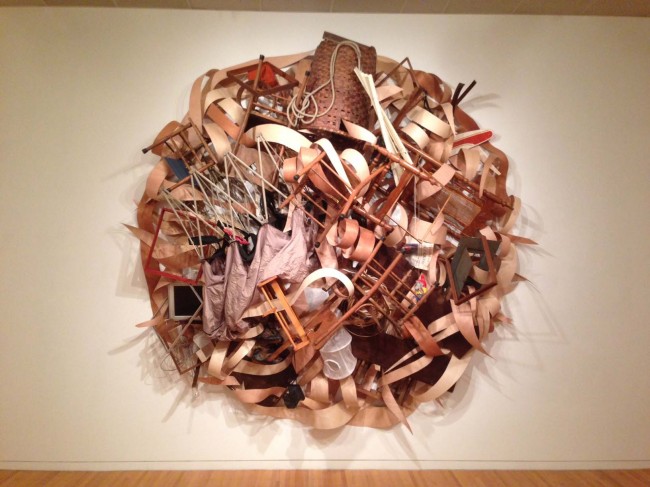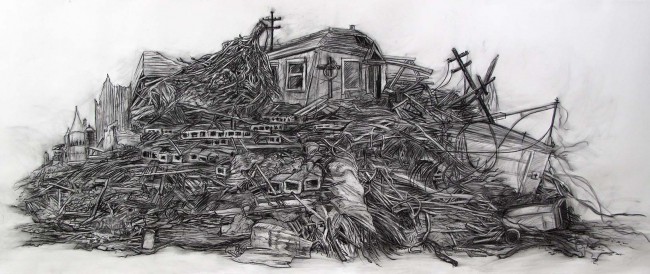by Keith Banner
Hollis Hammonds has close encounters of the terrestrial kind in her new show at DAAP Galleries called “Worthless Matter.” A stockpile and survey of her recent work, the show displays Hammonds’ skills at drawing and lets us in on a consciousness that is both vividly sedate to the point of entrancement, and formalized stiffly like a sleepy afternoon in a 1950s drafting class. In that mix of stolid and radioactive, terrestrial and extraterrestrial, Hammonds finds a way to transport herself (and the rest of us) into an inner-realm that shoplifts from catastrophe and builds a nest out of all the goodies.
Hammonds’ drawings (expansively and impressively executed mostly in ink, charcoal and pencil on vellum and paper, and installed with grace and mutability in the DAAP space) is like an avalanche reconfigured into lacework. Hammonds is a dreamer with a sketchbook who also understands that gravity contradicts yet aggrandizes her whims. It’s that understanding that makes each of her drawings completely solid and earthbound, while also allowing for volumes and volumes of ether to lift her oeuvre into outer-space.
Take for instance the title-piece, “Worthless Matter,” a litho-crayon-on-vellum masterpiece that riffs on James Rosenquist while dragging all his Pop-Art illusions through a Grapes of Wrath subterfuge. It’s a serious reconsideration of waste without any sense of nostalgia or longing. Hammonds draws the way Dick Tracey sees, a sort of X-ray vision that flattens the world into a clue too big to decipher, too small to ignore. Hammonds builds an asteroid here, and the result has a creepy dead-on glow that makes the real world feel a little lacking.
The same can be said of the “Smoke Rising” suite, a group of charcoal-paper circular drawings that seems to be channeling Sanskrit and fan-boy devastation simultaneously, and lovingly hung on the wall with crisp little push-pins that make the whole thing seem bedroom-wall beautiful. You could stare for days at these pieces, and eventually you might start hearing little messages that insects communicate right before an earthquake hits. Hammonds uses drawing with such grace and verve you follow her lines and scribbles outside of themselves right back into the picture itself without noticing the drama, the Armageddon being depicted. Plumes and planks and dark night skies roll up together into a nightmare constellation without any kind of warning or logic. It’s like seeing catastrophe without witnessing it.
I could go on and on of course.
“Worthless Matter” has that snapped-shut, hermetically sealed grandeur to it you always look for in one-person shows, a feeling of completion embellished with a sense of wonder and even wandering. The show has a limitless vitality, and yet a totally serene finish. In the more tightly controlled “In Ruins” sweep of drawings (some done in charcoal, some in ink), that sense of denouement gets formalized into funeral wreaths: broken doors, windows, chairs, earth, rocks, etc., all crunched into a perfect swallow of disaster. Hammonds seems to be reacting to technology and its nonstop fortress of communications somehow in those drawings, deconstructing televised aftermaths of tornadoes and hurricanes and tsunamis into perfect little logos, punctuation for people who see the end of the world every other day.
The one weak point in the show ironically is when Hammonds goes 3-D on us, in the found-object centerpiece of the show, “Worthless Matter: Forgotten Home,” a wood-veneer-and-junk combo that hangs on the wall like the drawings but also has a sinking sort of immutability about it. In the drawings, Hammonds finds escape; in this big jankety thing on the wall she finds a trap. Nestled within all the debris and artifice is a weather-beaten copy of The New York Times, which (like it or not) offers us a blatant reference to disaster. That is a buzzkill in a show that wants to both elevate and dig itself into a hole without finding any reasons or words for it. In that heady, gorgeous world Hammonds has created with her drawings, we are all in sync with something that can never be spoken, only drawn, exposed, and hung out to dry like clean laundry about to be swept away in a cyclone.







